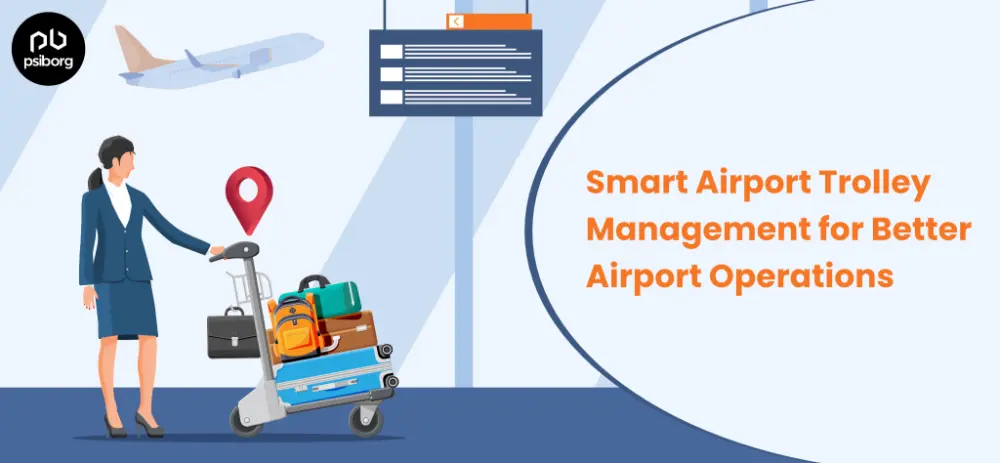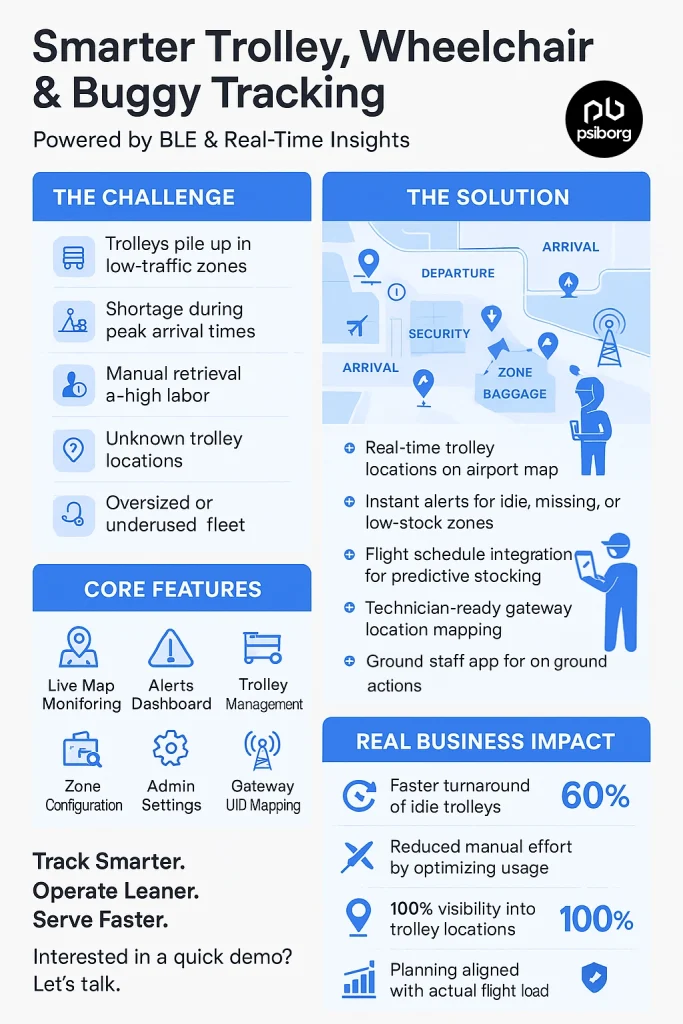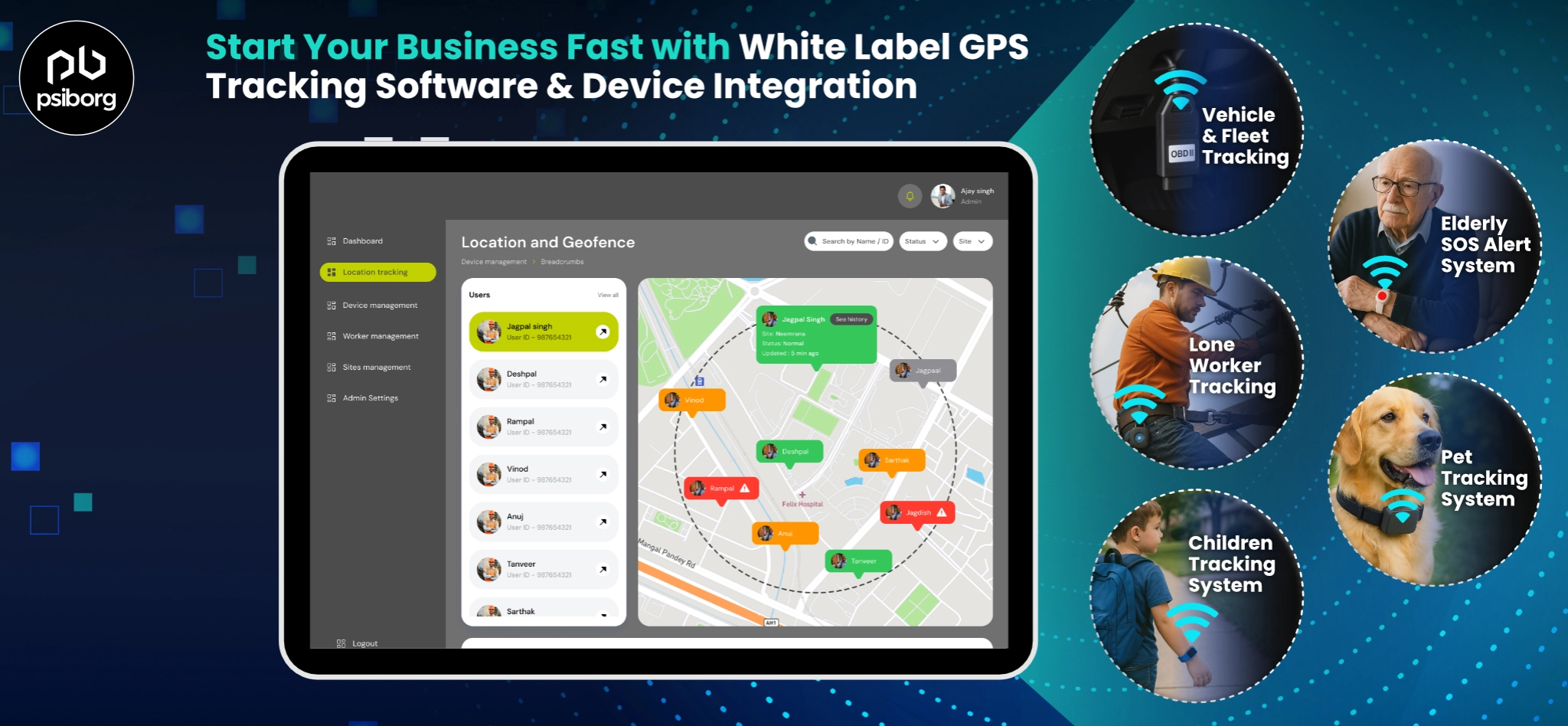Smart technology has revolutionized the management of airport trolleys completely. Managing the trolleys, which was easy enough in the old days, has now turned into a rather complex, technology-intensive function with the aim of answering calls from travellers and logistics optimization at an airport. The use of IoT-based smart trolleys based on BLE technology fundamentally changes the way an airport manages, tracks, and maintains trolleys. This aviation technology enables airports to optimize the usage of trolleys more effectively, reduces operational hiccups, and therefore enhances passenger experiences.
In this article, we will go deep into understanding how BLE technology is reforming the airport trolley tracking systems, its benefits, and what it truly does for airport functions. We shall examine the future of airport logistics with smart trolleys, further discussing how the world’s airports are embracing this transformative shift.
Understanding BLE Technology in Airport Trolley Tracking Systems

Engineers developed Bluetooth Low Energy as one of the most powerful wireless communication technologies to convey data with minimal energy over a short distance. This enables its use in applications that rely on small-size data transfers, like location tracking, which makes it ideal for airport trolley management. With its 2.4 GHz ISM band of operation, it provides enough range (up to 100 meters) to precisely track objects within large indoor areas, such as airport terminals.
By using BLE technology, BLE beacons can be affixed to each trolley for the management of airport trolleys. These BLE beacons will therefore constantly transmit their signals to receivers or gateways scattered around the airport. The signals received will then be forwarded through a central system where every trolley’s real-time location and status are tracked. This allows staff working in the airports to have real-time information about the availability of the trolleys, their locations, and how they have been used.
Benefits of Smart Trolleys for Airports
1. Real-Time Location Tracking
BLE-enabled trolleys ensure the availability of real-time location information so that airport staff can locate trolleys instantly anywhere inside the terminal. This results in the availability of enough trolleys in high-demand areas like baggage claims and check-in lines during peak travel seasons. It allows airport service employees to quickly recover and re-deploy available trolleys throughout the airport for smooth operations.
2. Enhanced Operational Efficiency
Using BLE-based tracking systems, airport staff can track trolley movements across terminals and identify shortages and bottlenecks very quickly. This provides staff with the exact whereabouts of trolleys at any particular time; thus, they can make even quicker decisions to have trolleys available when and where they are most needed. This can lead to controlling operational flow better while reducing passenger frustration resulting from shortages of trolleys.
Explore how PsiBorg Technologies’ Smart Trolley Tracking Solution transforms airport operations. This infographic highlights key challenges, our IoT-powered solutions, core features, and the real business impact of smarter trolley, wheelchair, and buggy tracking.

Footnote:
Business impact percentages represent expected outcomes based on RTLS industry benchmarks and previous asset-tracking deployments. Actual results may vary based on airport size, staff usage, and implementation scale.
3. Reduced Maintenance Costs
BLE technology also saves on maintenance costs. The tracking system enables the employees at the airport to track the condition and usage pattern of the trolley. The system would know which one is due for maintenance or repair so that the issue would be attended to without causing any further disruption. Preventive maintenance keeps smart airport trolleys longer in service, saving money on costly repairs and replacements
4. Improved Security and Loss Prevention
Another very overlooked advantage of BLE-based airport trolley management is the factor of security enhancement. Trolleys are commonly lost or stolen which is an enormous amount of loss for airports. The BLE technology allows for setting geofencing boundaries making sure that the trolly does not leave the designated boundary.Once a trolley crosses the boundary or someone takes it away without permission, it immediately sends alerts to the management team. This feature tremendously reduces the probability of trolley theft or misplacement.
How BLE-Based Smart Airport Trolleys Work?
The operation of BLE-based smart trolleys for airports revolves around the use of beacons, receivers, and sophisticated tracking software. Here’s how it all works:

1. BLE Beacons:
Each airport trolley has a BLE beacon, a small, battery-powered device that regularly emits short-range wireless signals. These signals contain data about the trolley’s ID and location.
2. Gateways/Receivers:
These are devices strategically positioned around the airport to capture the signals emitted by the BLE beacons. Gateways then transmit the data they receive to a central server or tracking system.
3. Centralized Tracking System:
The centralized system collects and processes the signals from multiple gateways. It uses algorithms to triangulate the position of each trolley, showing its exact location in real time on an interactive map. Mobile apps often integrate with this system, allowing airport staff to manage and monitor trolley availability and performance remotely.
The Triangulation Process
Researchers use a method called triangulation to determine the position of BLE beacons. Here’s how it works: when a trolley beacon transmits a signal, at least three gateways pick it up. Then the system takes the time for the signal to reach each gateway and measures the strength of the signal; they term this the Received Signal Strength Indicator or RSSI. The system uses this data to calculate the trolley’s precise location.
Triangulation ensures that though it’s happening in busy busy airports, the accurate location of trolleys will be followed; thereby, the distribution and the rate of availability of trolleys among the airport staff will be up to the mark.
Smart Airport Trolley Apps
A critical part of BLE-based trolley tracking systems is the smart app that accompanies the hardware. These apps are designed for airport staff to monitor trolleys on their smartphones or tablets. The app provides real-time data, offering a clear view of trolley locations and availability across different zones of the airport.
Key features of the smart airport trolley app include:
Real-Time Notifications: Staff receive instant alerts if trolleys move out of designated areas, need maintenance, or are running low in high-demand areas.
Interactive Maps: The app provides detailed, real-time maps of trolley locations, helping staff quickly find and redistribute trolleys to areas of need.
Custom Alerts: Staff can set up specific notifications to get alerts about trolley conditions, such as low battery power on the beacons or suspected theft.
These features enable quick response times and more efficient airport trolley management, improving the overall passenger experience.
Use Cases of BLE-Based Smart Trolleys in Airports
1. Passenger Convenience
With BLE beacons installed on trolleys, passengers benefit from the quick availability of trolleys. Airport staff can see where trolleys are concentrated and shift them to areas where travellers most need them. This reduces the time passengers spend searching for trolleys and ensures they have a seamless airport experience.
2. Optimized Fleet Management
With BLE, it would be possible to manage a large number of trolleys in an airport more effectively. The employees don’t need to look or count for trolleys because they can know the exact numbers and whereabouts of these in real time as soon as they want. This tracking system will help an airport handle its fleet of trolleys more effectively for smarter use of resources.
3. Predictive Maintenance for Cost Savings
The BLE-based tracking system helps in predictive maintenance by potential breakdown of a trolley at the right time and schedule maintenance. This approach can prevent sudden breakdowns of trolleys at the airport and avoid replacement costs, ensuring that trolleys remain in good condition for a longer time.
4. Improved Security
Smart trolleys equipped with BLE technology ensure that trolleys stay where they are supposed to be. If a trolley moves outside a designated area, the system triggers an alert. This helps prevent trolleys from being stolen or misplaced, reducing losses and protecting airport assets.
Key Features of Trolley Tracking Solution at Airports
IoT-Enabled Trolleys:
These trolleys carry BLE tags and strategically placed BLE gateways, which allows the airport to track their movement and location in real time.
Instant Trolley Availability:
The system shows where trolleys are located at important spots like the Departures Ramp and Baggage Belts at Arrivals, so passengers can easily find them.
Shorter Wait Times:
The IoT technology helps spread trolleys across the airport, making sure passengers don’t have to wait long to grab one.
Easy-to-Use Dashboard:
The airport team checks the trolley locations through a live dashboard, which they can access from phones, computers, or laptops, making it simple to manage.
Alert System:
The smart trolleys send alerts if they leave certain areas and are idle for long time, helping the staff quickly retrieve them and keep them to use.
Trolley Maintenance Report:
Builds a maintenance history of each trolley, including the number of trips or approximate distance traveled, and detects any under- or over-usage of particular carts.
Optimize Trolley pool size:
helps determine whether there are too many trolleys and if the pool size can be reduced.
This smart system makes the airport more efficient and helps passengers have a better travel experience.
Smart IoT-Enabled Trolley System at Rajiv Gandhi International Airport
Hyderabad International Airport also known as Rajiv Gandhi International Airport has launched India’s first smart trolley system by using IoT (Internet of Things) aiming at making everyone’s travelling a very smooth and efficient affair. This project is done following the government of India Digital India Programme that makes Hyderabad Airport at the forefront pertaining to advanced technology.
The Future of Smart Airport Trolley Management with IoT
The introduction of BLE technology in trolley management is only the beginning. As airports continue to adopt Internet of Things (IoT) solutions, we can expect even more innovation in this area. Airports are increasingly using IoT to connect various systems, such as baggage handling, security checkpoints, and now, trolley management.
In the near future, smart trolleys could be integrated into broader airport systems, using data from passenger flows to predict where trolleys are needed. Airports may also employ artificial intelligence (AI) to optimize trolley distribution and fleet management automatically. These developments will help airports provide better service while also improving operational efficiency and reducing costs.
Challenges of BLE Technology in Airport Trolley Management
While BLE offers numerous advantages, it also faces a few challenges. The range of BLE signals, though suitable for most airport environments, might not be enough for very large or complex facilities. Additionally, BLE beacons require battery replacements periodically, adding a layer of maintenance. However, with advancements in battery life and signal range, these challenges are becoming easier to manage.
Conclusion
The use of Bluetooth Low Energy technology leads to a new revolution in airport trolley management. BLE beacons-enabled smart trolleys make it possible for airports to control their fleet at unprecedented accuracy; thus, this approach propels efficiency, maximizes security, and reduces maintenance costs. Technology innovation makes airport trolleys available on or off when they are needed; that is, yet another way to enhance the passenger experience.
There only exists growth in using BLE technology as it evolves further. They only keep abreast with the status quo of technology in being innovative enough when they adapt to IoT-enabled smart trolleys, which airports in the process open pathways for even more connected, efficient, and passenger-friendly operations. The future of airport trolley management is bright and centred on BLE technology.
FAQs
An airport trolley management system helps track, organise, and move luggage trolleys around the airport. It makes sure trolleys reach the spots where passengers need them by using technology to watch their location and how they’re used.
A smart airport trolley tracking system:
- Guarantees trolleys stay ready for passengers at all times.
- Enhances the passenger experience by cutting down on waiting time.
- Reduces operational costs by trimming manual work.
- Discourages trolley loss or theft with tracking.
- Promotes efficiency and cuts waste by managing the right number of trolleys.
The system slashes downtime by ensuring trolleys remain in the right place. Real-time tracking lets staff quickly refill areas low on trolleys, preventing delays. Automated alerts keep trolleys in top condition by signalling when they need maintenance.





